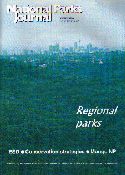|

Back to Contents
|
|
Ecologically
Sustainable Development |
ESD & national parks
Peter Hitchcock AM
Cairns based international environment and heritage consultant
formerly a Deputy Director of the NSW National Parks and Wildlife
Service
|
|
National
parks often appear as islands in a sea of development.
But can they withstand future developments which might wash ashore?
National parks and
other protected areas established for the conservation of natural
heritage should, as far as possible, be ecologically sustainable. But
is this truly the case and, if not, what is needed to get back on
track?
|
The first national parks, like Yellowstone, Yosemite
and Australia’s own Royal, were set aside primarily for ‘public enjoyment’,
read recreation. Since then the national park concept has continued to evolve.
Parks are now widely regarded as having a principal role of conserving natural
heritage, especially biodiversity. If this trend continues it will leave most
biodiversity eggs in the national park basket.
The problem
The reality is that, for a whole variety of reasons, many
parks and other protected areas are already compromised and their ecological
sustainability is in question. Some national parks may be sufficiently large and
buffered from human developments for ecological processes to continue,
independent of externalities. But the number of such areas is in decline across
the globe.
If national parks are not ecologically sustainable,
increasingly there will be a need for human intervention, an expensive and
problematic last resort, to be avoided if possible. It is more practical and
economic to provide for ecological sustainability than to play God in restoring
collapsed ecosystems. This is not a rosy picture and it certainly presents a
challenge.
| Ecological sustainability is not just an ideal for
national parks but increasingly will be essential for survival of the
biodiversity of the planet and, with it, survival of human civilisation
as we know it. However, the gulf between the rhetoric and reality of
ecologically sustainable development is still huge. For even our
national parks to achieve ecological sustainability, a new and concerted
wave of effort will be needed to increase the prospects of
sustainability. |

Photo:
Andrew Cox
A
"track" in Royal NP – access v sustainability
|
The setting
It would be overly simplistic to
conclude that all development within or adjacent to national parks further
threatens ecological sustainability. In certain circumstances development may be
benign or even enhance ecological sustainability. The impacts of tourism, indeed
a variety of developments in or adjacent to national parks, will depend very
much on the nature of the impact – and the effort to turn the negatives into
positives.
The strategic response to
environmental (read ecological) impact of proposed developments has evolved over
the past four decades. I characterise the stages in evolution of response
strategies as:
• disregard for ecological
impact
• impact minimisation
• no net impact
• net benefit
"Impact Minimisation":
This response was articulated in the 1960s and 70s with the advent of the
environmental impact statement (EIS). The long-term prognosis of its application
is progressive deterioration in the prospects of sustainability.
"No Net Impact":
The "No Net Impact" principle is founded on rigorous minimisation of
impacts of development, such impact being offset with some form of environmental
enhancement. I believe that the "NNI" objective is achievable in many
situations but achievement is not guaranteed in all cases. Application of the No
Net Impact principle will in the longer term achieve status quo at best.
"Net Benefit":
Recognising the evolution of strategic thinking about management of the impact
of development, I now actively promote the concept that I call the "Net
Benefit" (NB) principle. That development can deliver net environmental
benefit may sound a contradiction of terms. Admittedly it cannot work in all
cases but nevertheless it is a valid objective. If it has an application
anywhere, it will be in the management of national parks. As a management
objective it can be justified as a logical response to addressing the already
compromised ecological sustainability of many parks. It is code for ongoing improvement
in the sustainability of parks.
The long-term prognosis from
application of the Net Benefit principle to all activities in national parks is
incremental improvement in the prospects for ecological sustainability. The Net
Benefit principle has been embodied in the management of the Wet Tropics World
Heritage Area, where real benefits can already be demonstrated. Similarly I have
introduced the principle into the new park and reserve system in Lebanon.
The three strategies outlined can be
considered and applied as management principles, not just to address impacts of
proposed development but to guide all national park management activities.
However, the order in which they are applied is critically important. The
highest hurdle must be applied first and only lowered if it has been proved
beyond doubt that it cannot be achieved.
For example, the first test of a
development proposal, inside or adjoining a park, should be to assess if the
development can be designed to contribute a net benefit to the park, especially
in terms of ecological sustainability. Only if that proves to be not prudent and
feasible is the bar lowered to the No Net Impact principle. I believe it is no
longer responsible to resort to the Impact Minimisation principle in an age
supposedly committed to ecological sustainability.
The best example that I can quote of
practical application of the Net Benefit principle is in the Wet Tropics World
Heritage Area where a proposed major powerline was approved only after the
withdrawal of three existing powerlines was negotiated. The Net Benefit arises
from high-lift cabling above the rainforest to avoid clearing, together with the
revegetation of existing powerline clearings. The result: a net increase in
rainforest area as well as improved habitat connectivity.
|
Conclusions
Given that many national
parks and protected areas are not ecologically sustainable, it is no
longer sufficient to adopt a management strategy of Impact
Minimisation or even of maintaining status quo by No Net Impact. A
much more proactive approach is necessary to progressively improve
the prospects of ecological sustainability. That includes innovative
approaches to ensure that any development which occurs in or near
national parks has a Net Benefit, if at all possible.
Also required is a
commitment to a proactive approach to national park management; to not
just manage them as islands, but to manage them as an integral part of
the wider sea of development.
If ongoing planning of
national parks is fully integrated into the wider field of sustainable
land use, they can play an important catalytic role in promotion of
the new culture of sustainable development in the community. Managed
in isolation many parks will not only fail to be ecologically
sustainable but will make much less contribution to ecological
sustainability of life in general.
If we cannot achieve
ecological sustainability for the cream of our national parks then
there is little prospect of the human population, the ‘boat people’
adrift in the ocean of development, achieving ecological
sustainability on the increasingly turbulent high seas.
And for anyone
contemplating development in or near a national park: ‘Ask not what
the national park can do for you, but what you can do for the national
park.’
* Peter Hitchcock
is a Cairns based international environment and heritage consultant
and was formerly the first Executive Director of the Wet Tropics
Management Authority, a Deputy Director of the NSW National Parks and
Wildlife Service. He has served two terms on the Australian Heritage
Commission.
|


